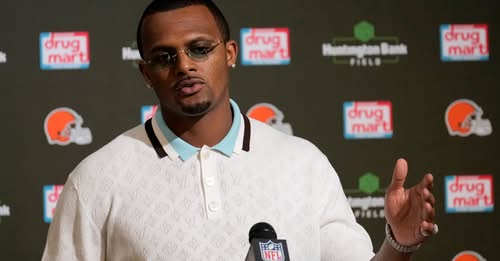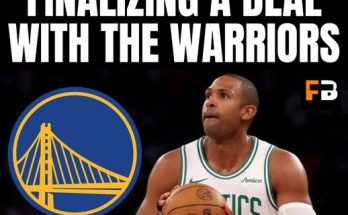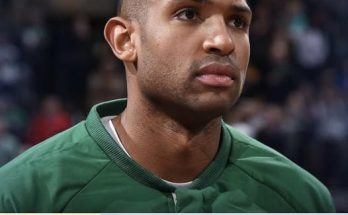The news reverberated through the NFL like a tremor, shaking the very foundations of the Cleveland Browns’ 2025 aspirations. Star quarterback Deshaun Watson, the highly paid and often embattled centerpiece of their offensive hopes, has officially been placed on the Physically Unable to Perform (PUP) list, with the grim expectation that he will miss the entire upcoming season. This isn’t just a setback; it’s a monumental blow, a grim pronouncement that casts a long, dark shadow over a franchise desperate for stability and success. The culprit? Lingering shoulder issues and, as recently revealed, a re-ruptured Achilles tendon that has severely complicated his rehabilitation and pushed his return timeline far beyond what anyone initially anticipated.
To understand the magnitude of this development, we must first delve into the intricacies of the NFL’s Physically Unable to Perform list. The PUP list is a designation for players who, due to football-related injuries sustained prior to the start of training camp, are unable to practice. There are two forms: the Active/PUP list, which applies during training camp, and the Reserve/PUP list, which comes into play once the regular season begins. A player on the Active/PUP list can be activated at any point during training camp once medically cleared. However, if a player remains on the PUP list when the final 53-man roster is set at the end of the preseason, they are then moved to the Reserve/PUP list. This is the crucial distinction: being placed on the Reserve/PUP list mandates that the player miss at least the first four weeks of the regular season. After that initial period, the team has a five-week window to allow the player to begin practicing, and once they do, an additional 21-day window to activate them to the 53-man roster. If either of these deadlines passes, the player must remain on the PUP list for the remainder of the season, effectively ending their playing year. In Watson’s case, the severity and protracted nature of his current injuries, particularly the re-ruptured Achilles, mean that the expectation is he will not be cleared within these windows, thus ensuring he will miss all of 2025. This isn’t a speculative absence; it’s a codified reality under league rules.
Deshaun Watson’s tenure in Cleveland has been a saga marked by controversy, massive financial commitment, and, most notably, a stark lack of on-field availability. Acquired in a blockbuster trade with the Houston Texans in 2022, a deal that cost the Browns three first-round picks and a fully guaranteed $230 million contract, Watson was supposed to be the franchise quarterback who finally ended their decades-long search for consistent excellence under center. Instead, his time has been plagued by an 11-game suspension in 2022 for violating the NFL’s personal conduct policy, followed by back-to-back seasons ending on injured reserve.
His shoulder issues, which had been a persistent concern, initially forced him to miss significant time in the 2023 season. While he managed to return, a new injury, a micro-tear to his rotator cuff, ultimately sidelined him again. The hope, then, was for a full recovery and a fresh start in 2025. However, fate, or perhaps the relentless physical toll of professional football, had other plans. In January of this year, a shocking development emerged: Watson had suffered an Achilles injury. What was initially believed to be a significant setback in his overall recovery was later revealed to be a re-rupture of the Achilles tendon, an even more devastating blow that effectively reset his entire rehabilitation timeline. This re-injury, occurring less than three months after the initial tear, amplified concerns not just about his immediate future, but his long-term viability as a top-tier NFL quarterback. The nature of Achilles injuries, especially re-ruptures, is notoriously challenging, often leading to a prolonged and arduous recovery period. The precedent set by other star players, such as Kirk Cousins and Aaron Rodgers, who have faced their own struggles with mobility and performance after returning from Achilles tears, only adds to the trepidation surrounding Watson’s outlook.
The financial implications of Watson’s absence are staggering. His fully guaranteed contract, a groundbreaking deal at the time, means the Browns are still on the hook for his exorbitant salary, even as he remains sidelined. For 2025, he accounts for nearly $36 million against the salary cap, and due to several contract restructures, his cap hit balloons to an eye-watering $80.7 million in 2026. This is a significant burden for any team, let alone one grappling with a fundamental question mark at its most critical position. The investment was immense, and the return has been minimal, leading team owner Jimmy Haslam to publicly acknowledge in March that the Browns “took a big swing and miss” with the trade, a candid admission of a profoundly disappointing outcome. This financial reality complicates any potential future moves and limits the team’s flexibility in addressing other roster needs.
The immediate and profound impact of losing a starting quarterback, especially one of Watson’s caliber (or at least, his perceived caliber when acquired), cannot be overstated. In the NFL, the quarterback is the undisputed linchpin of an offense, the orchestrator of plays, the primary decision-maker, and often, the emotional leader of the team. A significant injury to this position often sends ripples of uncertainty and apprehension throughout the entire organization, from the coaching staff to the locker room to the fanbase. Research consistently shows a direct correlation between quarterback health and team success; teams with stable, high-performing quarterbacks are far more likely to contend for championships. When that stability is shattered, particularly by a long-term absence, the entire offensive scheme may need to be overhauled, player roles redefined, and expectations drastically adjusted.
For the Cleveland Browns, Watson’s absence thrusts them into a familiar, yet unwelcome, state of quarterback limbo. The team has been proactive in trying to mitigate the risk, assembling a quartet of signal-callers to compete for the starting job in his stead. Veteran Joe Flacco, who led the Browns on an improbable playoff push last season after Watson went down with his initial shoulder injury, is back and offers a proven, albeit aging, presence. Kenny Pickett, acquired in a trade from Philadelphia, brings youth and former first-round draft pedigree, looking for a fresh start. And then there are the rookies, Dillon Gabriel and Shedeur Sanders, drafted in the third and fifth rounds respectively, representing the Browns’ long-term investment in the position.
This “four-person quarterback competition” is arguably the most intriguing storyline heading into Browns training camp. Each quarterback presents a different profile and skill set. Flacco, the grizzled veteran, offers a strong arm and a deep understanding of the game, but his mobility is limited. Pickett, despite his struggles in Pittsburgh, has flashed potential and could thrive in a new environment. Gabriel and Sanders, as rookies, possess untapped potential but will face a steep learning curve in the NFL. The coaching staff, led by Kevin Stefanski and offensive coordinator Tommy Rees, will have the challenging task of evaluating this diverse group and determining who gives the team the best chance to win. This isn’t just about picking a starter; it’s about building an offense around that player’s strengths and adapting to their limitations. The challenge will be particularly acute in establishing chemistry with the receiving corps and offensive line.
Beyond the quarterback position itself, Watson’s absence will undeniably impact the entire team’s outlook. The Browns boasted a formidable defense in 2024, a unit that often kept them in games despite offensive inconsistencies. That defense will be under even greater pressure in 2025 to perform at an elite level, knowing the margin for error on offense will be significantly smaller. The running game, spearheaded by Nick Chubb (who himself is returning from a significant injury), will likely be leaned upon heavily to control the clock, chew up yardage, and take pressure off the new starting quarterback. The offensive line, which has generally been a strength, will need to maintain a high level of play to protect whoever is under center and open lanes for the run game.
The ripple effects extend beyond the field. The psychological impact on the team, particularly the veteran players who committed to Cleveland with the expectation of contending with Watson at the helm, is a factor to consider. Maintaining morale and belief in the face of such a significant injury to a highly compensated star will be a test of leadership for Stefanski and his coaching staff. For the fanbase, already accustomed to the rollercoaster of emotions that comes with being a Browns fan, this news is a bitter pill to swallow. The hope and excitement that typically surrounds the start of a new NFL season will undoubtedly be tempered by the stark reality of Watson’s extended absence.
Looking ahead, the Browns’ strategy for the 2025 season will be a fascinating case study in adaptability and resourcefulness. The immediate focus will be on the quarterback competition, identifying a leader, and building a cohesive offensive identity. The coaching staff will need to design game plans that play to the strengths of their new starter while minimizing weaknesses. This might mean a more run-heavy approach, a greater reliance on play-action, or a simplification of the passing scheme to ease the transition for a less experienced quarterback. The pre-season will be crucial for these new signal-callers to get acclimated to the speed of the NFL game and build rapport with their teammates.
Furthermore, the long-term implications of Watson’s contract and recurring injury issues will loom large over the franchise. With such a massive financial commitment tied to a player who has struggled to stay on the field and perform at the level expected, the Browns face difficult decisions down the line. Can they realistically move on from such a contract if Watson continues to be unreliable? Or will they be forced to ride out the remainder of his deal, hoping for a miraculous recovery and return to form? The drafting of two quarterbacks in the recent draft signals a recognition that a contingency plan, and perhaps even a succession plan, is desperately needed. The “swing and miss” acknowledged by Haslam highlights the urgency of finding a stable, long-term solution at quarterback, a quest that has defined this franchise for decades.
In an educative sense, Deshaun Watson’s situation serves as a stark reminder of several key aspects of professional sports. Firstly, it underscores the brutal physical demands of the NFL and the inherent fragility of even the most finely tuned athletic machines. Injuries are an undeniable part of the game, and even minor setbacks can have cascading effects on a player’s career and a team’s fortunes. Secondly, it illustrates the enormous financial risks involved in blockbuster player acquisitions, particularly for quarterbacks. The guaranteed contract to Watson was unprecedented at the time, and its consequences are now being felt acutely. This kind of deal, while designed to secure a top talent, also creates significant inflexibility if the investment doesn’t pan out. Thirdly, it highlights the paramount importance of the quarterback position in modern football. No other position dictates a team’s success or failure to the same degree, and the absence of a star player at this spot creates a void that is almost impossible to fill completely.
The Cleveland Browns’ 2025 season will be a true test of resilience. They possess a talented roster in other areas, a strong coaching staff, and a fiercely loyal fanbase. However, the path to contention has been made immeasurably more challenging by the news of Deshaun Watson’s extended absence. The focus now shifts to the unproven and the veteran bridge options, a compelling narrative of adaptation and the enduring struggle for quarterback stability in the unforgiving landscape of the National Football League. The coming months will determine if the Browns can once again defy expectations and find a way to compete without their designated franchise cornerstone, or if this latest setback will relegate them to another season of unfulfilled promise. The lessons from this situation extend far beyond the gridiron, offering insights into risk management, strategic planning, and the unpredictable nature of human performance at the highest levels of athletic competition.



